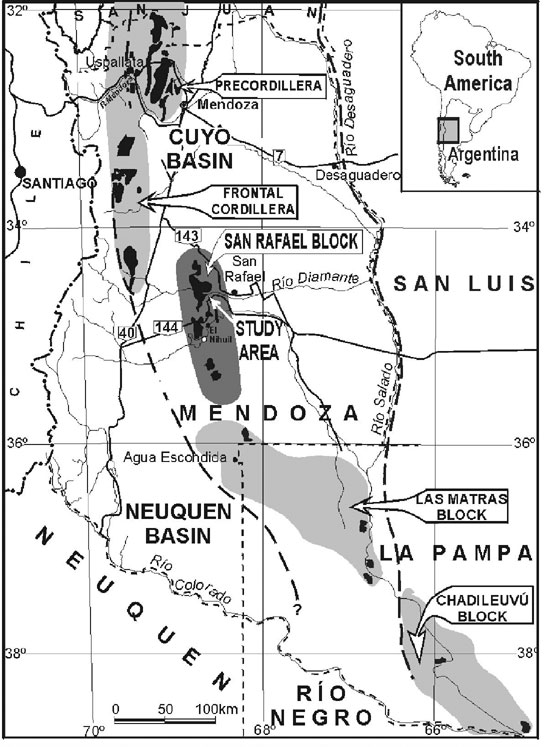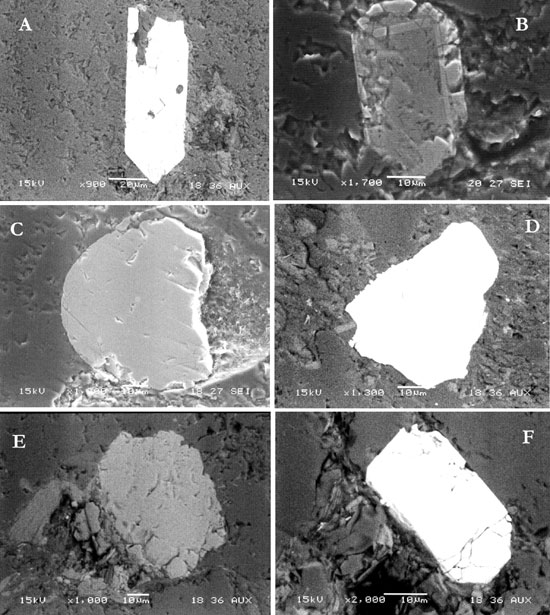
Pavón Formation zircons under scanning electronic microscope: preliminary results on the Ordovician siliciclastics from the San Rafael Block, Mendoza
Paulina Abre1–2, Udo Zimmermann2 and Carlos A. Cingolani1
1 Centro de Investigaciones Geológicas – Universidad Nacional de La Plata – calle 1 Nº 644, 1900 La Plata, Argentina. E–mail: paulinabre@yahoo.com.ar
2 Department of Geology, RAU University, Auckland Park 2006 – Johannesburg – South Africa. E–mail: uz@na.rau.ac.za
Key words: San Rafael Block. Mendoza. Gondwana margin. Ordovician. Heavy minerals.
Introduction
The San Rafael Block (SRB) lies in the South of the Mendoza province, central Argentina. Cuyo and Neuquén oil basins bound it to the North and Southwest respectively. To the West the Andean Cordillera limits it and to the East it is cover by Quaternary deposits and back–arc volcanic units. It has a SSE–NNW structural trend as a response to the Cenozoic Andean tectonic. The SRB includes igneous, metamorphic and sedimentary rocks from Precambrian to Paleozoic ages (formally described as "Pre–Carboniferous units") clearly differentiated from Upper Paleozoic beds by a regional unconformity. An important Permian–Triassic magmatism is developed and also Cenozoic volcanism. The SRB is a key area in the evolution of the proto–Andean margin of SW Gondwana, as the southern continuation of Precordillera terrane.
The objective of this paper is to present preliminary data about SEM (Scanning Electronic Microscope) heavy minerals analyses of the Ordovician siliciclastic Pavón Formation (Holmberg, 1948 nom. subst. Cuerda and Cingolani, 1998). This work is part of first author’s PhD thesis who is studying the provenance of clastic rocks, during and after the Precordillera terrane accretion, supposed to happened during the Upper Ordovician–Silurian time (Ramos, 1999, and references therein).
Pavón Formation main characteristics
Previous studies of the Pavón Formation related to stratigraphy, structure and geochemistry were carried out by Cuerda and Cingolani (1998); Cuerda et al. (1998, 1999); Manassero et al. (1999) and Cingolani et al. ( 2002, 2003).
The Pavón Formation crops out in the central region of the SRB (Figure 1); an association of massive green–reddish–gray sandstones, wackes, quartz sandstones, siltstones and interbedded shales composes it. Their sand–dominated facies has regular tabular bedding with sharp contacts, scarce syndepositional deformation structures and 700 m of thickness. There is an abundant graptolite fauna within fine sediments, which allow determining an Early Caradoc age, based on the Climacograptus bicornis Biozone. A turbidite sand–rich ramp is the depositional model proposed (Manassero et al., 1999). Sandstone petrography recorded the following minerals: quartz, K–feldspars, plagioclase, biotite, muscovite, opaques, tourmaline, zircon, apatite, hematite and sedimentary and metamorphic rock fragments. Illite crystallinity values measured by X–ray diffraction in shales suggest anchimetamorphic grade conditions.

Figure 1. Location of the study area in the San Rafael Block at the central-western region of Mendoza Province, Argentina. In black are presented the "pre-Carboniferous" rock outcrops in different western Argentine geological units.
Major elements geochemistry, documents a significant mobility due to alteration and weathering by evolved the Chemical Index of Alteration (CIA) and the Chemical Index of Weathering (CIW) values (Cingolani et al., 2002). The chondrite–normalized REE patterns show a moderately flat shape and a pronounced negative Eu anomaly due to relatively scarce plagioclase in the Pavón Formation sandstones. The similarity of the Pavón Formation REE patterns with the post–Archean average shale composite (PAAS) points to an average upper crustal composition. The 1.4–1.5 Ga Nd model ages (TDM) obtained for the Pavón Formation allows us to speculate that these could be derived from the nearest Grenvillian–age crustal source (Cerro La Ventana Formation) that shows quite similar Nd model ages (Cingolani et al., 2003). However, the low quantity of samples analyzed (five) may not be statistically meaningful. Petrographical, geochemical and paleocurrent data suggest a recycled orogen and or continental block as an eastern source area. The Grenvillian–age (Cingolani and Varela, 1999) igneous–metamorphic rocks located eastward to the Pavón Formation outcrops are mainly amphibolites and granodioritic, tonalitic to dioritic rocks. These granitoid derived rocks are essentially composed of plagioclase, quartz, amphibole, biotite and alkali feldspar, with opaque minerals, apatite, zircon and sphene as accessory minerals. All plotted as metaluminous rocks with a primitive signature. It is important to note that were recognized in some granitoid samples, euhedral to subeuhedral zircon grains of different colors whose U–Pb geochronology are in progress.

Figure 2. Zircons microphotographs: A. Zircon under BSE; elongate euhedral grains could have a volcanic origin. B. Zonated zircon under SEM; different stages of growth are evident. C, D. Rounded zircons under SEM and BSE; roundness is an indicator of reworking, but well rounded zircons could form through in situ growth of a metamorphic rim around an originally euhedral grain. E. Anhedral apatite under BSE. F. Euhedral zircon under BSE.
Heavy minerals recognized
The study of heavy minerals is an important tool in reconstructing the history of a sedimentary basin. The occurrence of some types of heavy minerals is of particular interest, as they are related to well defined tectonic settings. Reworking and selective sorting during transportation concentrates resistant heavy minerals like zircon, apatite and monazite. Hydraulic sorting of trace element concentrating heavy minerals can influence the chemical composition of a sedimentary rock (Cullers et al., 1979; Mass et al., 1991). The increase in Zr is shown by the ratio Zr/Sc and the evolved values point to a reworking component in the rocks. In the Pavón Formation samples zircon is the most abundant heavy mineral; it is also the major host of Zr (average 23; n=24) and Hf and it is enriched in HREE. Zircon crystallizes in most plutonic rocks, in intermediate to differentiated lavas and could also recrystallized in high–grade metamorphic rocks (Pupin, 1980). Their primary characteristics are preserved in sedimentary and low–grade metamorphic rocks, and their morphology distribution is not affected by grain size variations. The types and sub–types of zircon found in the sediments are indicative of the different natures of their source rocks (Pupin, 1980).
Preliminary SEM analyses
Several polished thin sections of the Pavón Formation were analyzed on a scanning electron microscope using also energy dispersive spectrometry (SEM–EDS–BSE), at the Centralized Analytical Facility, RAU, Johannesburg, South Africa. The SEM was a JEOL JSM–5600, with a tungsten filament and EDS analyses were done using a Noran X–ray detector and Noran Vantage software. The SEM–EDS–BSE system was set at 15 keV, a working distance of 18 mm and a live time of 60 s per spot.
In SEM–EDS–BSE microphotographs is possible to distinguish subhedral and euhedral (Figure 2a–f) zircons in almost equal quantities; only a few of them show zonation (Figure 2b). Rounded grains are also present (Figure 2 c–d); roundness normally is used as an indicator of extensive transport or reworking, but well rounded zircons could form also in situ by over–growth during metamorphism around an originally euhedral grain (Hanchar and Miller, 1993). Elongate euhedral grains are less common and could have a volcanic origin (Figure 2a). Other heavy minerals identified by their EDS spectra in order of abundance are: anhedral apatite (Figure 2e), subhedral rutile and very scarce sphene.
These preliminary results are coherent with the hypothesis that in the San Rafael region the Pavón Formation received their clastic detrital material mainly by the Grenvillian–age crust and subordinated from the Famatinian sector. However, trace elements signatures pointing to a magmatic arc source, but a distinct volcanic arc signature could not be found so far. Zircon analyses show interesting aspects of source mixing. Metamorphic zircons are abundant as well as volcanic derived crystals. The latter signature is not visible in geochemistry.
U–Pb geochronological studies (single crystal method) on mentioned detrital zircons are in progress at de Isotope Geology Laboratory, UFRGS, Porto Alegre (Brazil) and further isotope analyses on zircons by ICP–MS–LA (RAU, Johannesburg, South Africa) will try to differentiate the zircon populations. Such studies can provide first–order constraints on the terrane paleogeographic evolution.
References
Cawood, P.A. and Nemchin, A.A. 2000. Provenance record of a rift basin: U/Pb ages of detrital zircons from Perth Basin, Western Australia. Sedimentary Geology, 134: 209–234.
Cuerda, A.J. and Cingolani, C.A. 1998. El Ordovícico de la región del Cerro Bola en el Bloque de San Rafael, Mendoza: Sus faunas graptolíticas. Ameghiniana, 35(4):427–448.
Cingolani, C.A. and Varela, R. 1999. The San Rafael Block, Mendoza (Argentina). Rb–Sr isotopic age of basement rocks. II South American Symposium on Isotope Geology, Anales XXXIV SEGEMAR, Actas: 23–26, Villa Carlos Paz, Córdoba.
Cingolani, C.A., Cuerda, A. and Manassero, M. 1999. Litoestratigrafía de los depósitos silicoclásticos ordovícicos del Cerro Bola, Bloque de San Rafael, Mendoza. XIV Congreso Geológico Argentino, Actas 1:409–413. Salta.
Cingolani, C.A., Manassero, M. and Abre, P. 2002. Geoquímica de elementos traza y tierras raras de las sedimentitas de la Formación Pavón, Ordovícico del Bloque de San Rafael, Mendoza. XV Congreso Geológico Argentino, CD–ROM version. Actas 1:667–673. Calafate.
Cingolani, C.A., Manassero, M. and Abre, P., 2003. Composition, provenance and tectonic setting of Ordovician siliciclastic rocks in the San Rafael Block: Southern extension of the Precordillera crustal fragment, Argentina. Journal of South American Earth Sciences Review, 16 (1) IGCP 436 Pacific Gondwana Margin Special Issue.
Cullers, R.L., Chaudhuri, S., Kilbane, N., Koch, R., 1979. Rare earths in size fractions and sedimentary rocks of Pennsylvanian–Permian age from the mid–continent of the U.S.A. Geochimica et Cosmochimica Acta, 43, 1285–1302.
Hanchar, J.M. and Miller, C.F., 1993. Zircon zonation patterns as revealed by cathodoluminescence and backscattered electron images: Implications for interpreting complex crustal histories. Chemical Geology, 110:1–13.
Holmberg, E., 1948. Geología del Cerro Bola. Contribución al conocimiento de la tectónica de la Sierra Pintada. Secretaría de Industria y Comercio de la Nación. Dirección General de Industria y Minería. Boletín 69:313–361. Buenos Aires.
Manassero, M., Cingolani, C.A., Cuerda, A.J. and Abre, P. 1999. Sedimentología, Paleoambiente y Procedencia de la Formación Pavón (Ordovícico) del Bloque de San Rafael, Mendoza. Revista de la Asociación Argentina de Sedimentología, 6 (1–2):75–90.
Mass, R. and McCulloch, M.T., 1991. The provenance of Archaean clastic metasediments in the Narryer Gneiss Complex. Western Australia: trace element geochemistry, Nd isotopes, and U–Pb ages for detrital zircons. Geochimica et Cosmochimica Acta, 55, 1915–1932.
Pupin, J. P., 1980. Zircon and granite petrology. Contributions to Mineralogy and Petrology 73, 207–220.
Ramos, V.A., 1999. Rasgos estructurales del territorio argentino. I. Evolución tectónica de la Argentina. In: Geología Argentina, Anales SEGEMAR 29:715–784.
Received: February 15, 2003
Accepted: June 15, 2003